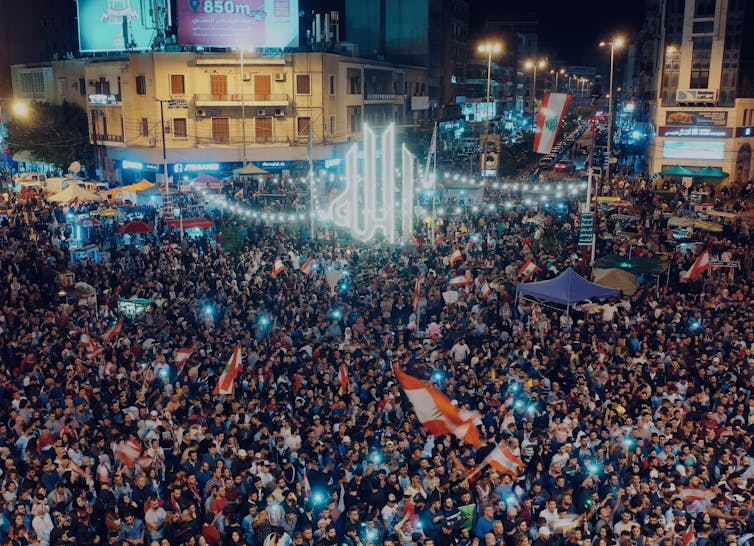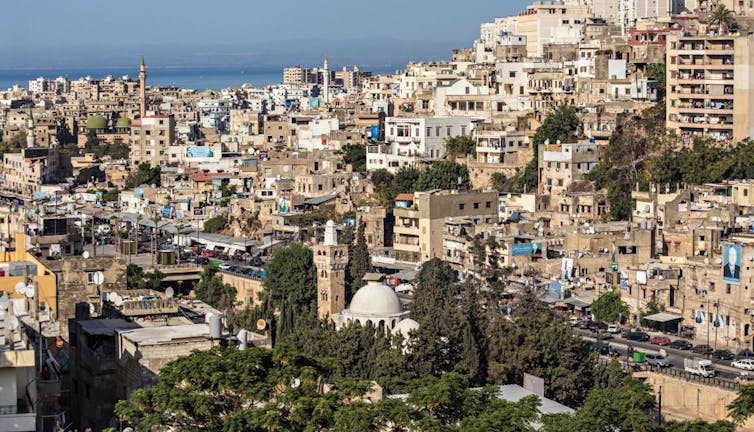
Photo courtersy of Omar El Imadi
Rola El-Husseini, Lund University
The continuing protests in Lebanon have drawn attention to the city of Tripoli, described as the “bride” of the uprising. Sahet al-Nour, or Light Plaza, a square in the south of Tripoli, has been the centre of some of the largest and most sustained demonstrations in Lebanon in recent weeks.
It has also been the site of some of the most iconic pictures of the protests. These include videos of a “protest rave” that took place on October 19, and the photo of a one-legged man cleaning the streets in a demonstration of civic spirit.
The sizeable demonstrations in Tripoli have brought people from all classes, genders and religions, to the streets to demand the fall of the sectarian political elites that have ruled Lebanon since the end of the civil war in 1990.
Tripoli, the second-largest city in Lebanon, sits on the northern coastline. It’s a mainly Sunni city with decreasing numbers of Christian minorities, mainly Greek Orthodox with a small minority of Maronites, and some Alawis. Tripoli’s larger environment is also mainly Sunni, and the Akkar plain, which stretches from Tripoli northward to Syria, is the most underprivileged and deprived region in Lebanon.
Yet the city is home to two of the richest men in the country, the former prime minister Najib Mikati and the MP Mohammed Safadi, a former finance minister. It’s been perceived by the Sunni ruling elite as its “reservoir” of dependable votes.
Lebanon’s ‘Kandahar’
The city has grown tremendously in recent decades, in part due to a large influx of Sunni residents from the surrounding rural areas. New parts of the Abu Samra neighbourhood have emerged in the past 40 years, creating an urban sprawl that has taken over many of the olive groves on the hills overlooking the city. As Abu Samra has grown and de-gentrified, its new areas have increasingly attracted jihadists and salafists.
Values considered alien to the city have made an appearance in these areas – for example an increasing number of women wearing black abayas and the niqab (face veil). Such attire was a very rare sight in the 1970s and 1980s when I was growing up in (now Old) Abu Samra. It was then a middle-class neighbourhood where women wore non-religious – albeit modest – clothes with, at most, a hair covering as a nod to tradition.

By Sun_Shine/Shutterstock
In recent years, the Lebanese press has frequently compared Tripoli – parts of which are traditional and conservative – to the Afghan city of Kandahar, another bastion of Islamic conservatism. Tripoli boasts a large number of urban poor and a 2015 UN study found that more than 50% of the population are living at or below the poverty line.
Poverty is institutionalised and the city’s leaders have made no effort to bring money into the city, or to create projects that would help the poor to better themselves. This absence of poverty alleviation efforts is an attempt to keep the poor beholden to local politicians who provide free services in exchange for political support.
The people on the streets are protesting these client networks and the accompanying graft and corruption. They are frustrated that their reliability as voters for the Future Movement of caretaker prime minister, Saad Hariri, and for the city’s political representatives has been taken for granted. The strength of the popular movement has led some to dub the protests in Tripoli as the revolution of the poor.
City of contrasts
But Tripoli is a city of contrasts and extremes. It’s not merely the habitat of the poor and the conservative. It’s also a city of beach resorts where women tan in revealing bathing suits and where the jeunesse dorée meet to flirt and date. Tripoli is also a city where well-off women wear skimpy designer dresses, carry Chanel bags, and drink mojitos, and where the men smoke Cuban cigars and nurse single-malt whiskeys – as I witnessed during a high school reunion a few years ago.
There are many Tripolis – including a Westernised, “modern” city with its well-off, highly educated denizens, and the “old” conservative districts. All of the city’s established families originated from these older areas but today they have been given over to migrants from the rural areas and to poverty. These Tripolis are now meeting in Sahet al-Nour and standing shoulder to shoulder to demand their rights. After all, the lack of infrastructure and services affects the rich as well as the poor.
Over the past few years, Tripolitans have come to resent the fear-mongering of the press, especially after the years of conflict when the Syrian war spilled over into the city. The current uprising taking place in Lebanon with its call for national unity has shattered the stereotypical image of the city as “the bastion of Muslims”, the inscription found at the entrance of the city.
Tripoli has shed its image as a jihadist city, full of hatred towards “others” – be they Christian or Shi’a. Like Homs, known as the capital of the Syrian revolution, with which it shares mercantile and familial relations, Tripoli has come to represent the mutiny of neglected provincial Arab cities against the increased centralisation of power and money in Arab capitals.
The Arab uprisings have been described as the “revolt of the peripheries”, and the current unrest in Tripoli is a stark reminder of that.![]()
Rola El-Husseini, Associate Professor, Director of Studies, Centre for Middle Eastern Studies, Lund University
This article is republished from The Conversation under a Creative Commons license. Read the original article.




28 Comments
Pingback: relax
Pingback: adhd doctors fairfax va
Pingback: his explanation
Pingback: https://jjapp.xyz/2024/02/03/81/
Pingback: magic mushroom victoria
Pingback: More about the author
Pingback: รับทำวิจัย
Pingback: เติม เงิน ps4
Pingback: เพิ่มผู้ติดตาม
Pingback: หาฤกษ์คลอด
Pingback: หนังเอวีซับไทย
Pingback: gray zone hack
Pingback: เศษผ้า
Pingback: Nexus Market
Pingback: gaming pc
Pingback: แทงบอลสด
Pingback: สล็อต เครดิตฟรี
Pingback: Aviator bet
Pingback: สูตรสล็อตทดลองเล่นฟรี มีประโยชน์ในการเดิมพันอย่างไร?
Pingback: Aviator
Pingback: fruit cocktail casino
Pingback: sawan168 slot
Pingback: fortuneox777.com
Pingback: เซรั่มหอมแดง
Pingback: mim66
Pingback: ทะเบียนรถสวย
Pingback: ชุดกระชับสัดส่วน
Pingback: fear of god essentials